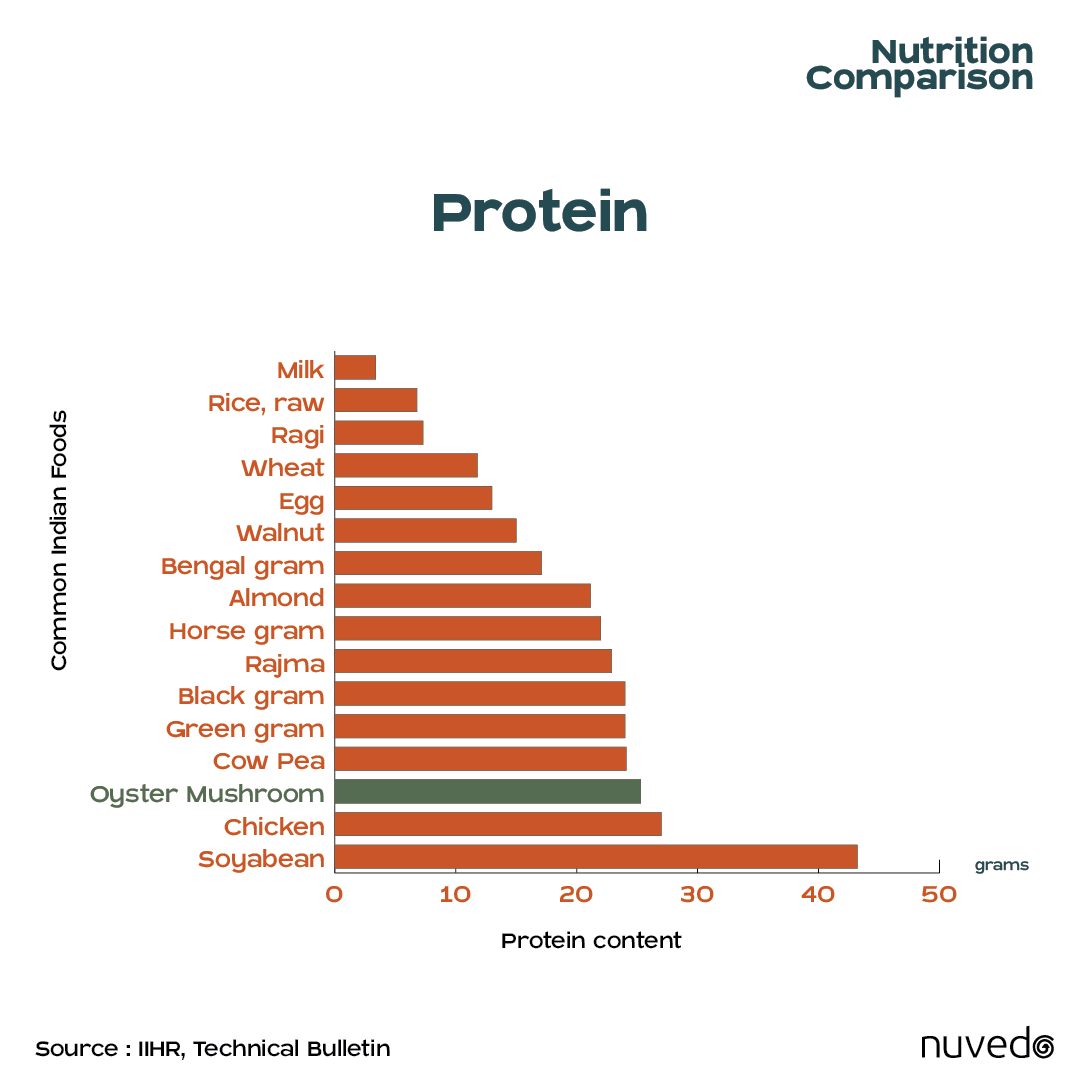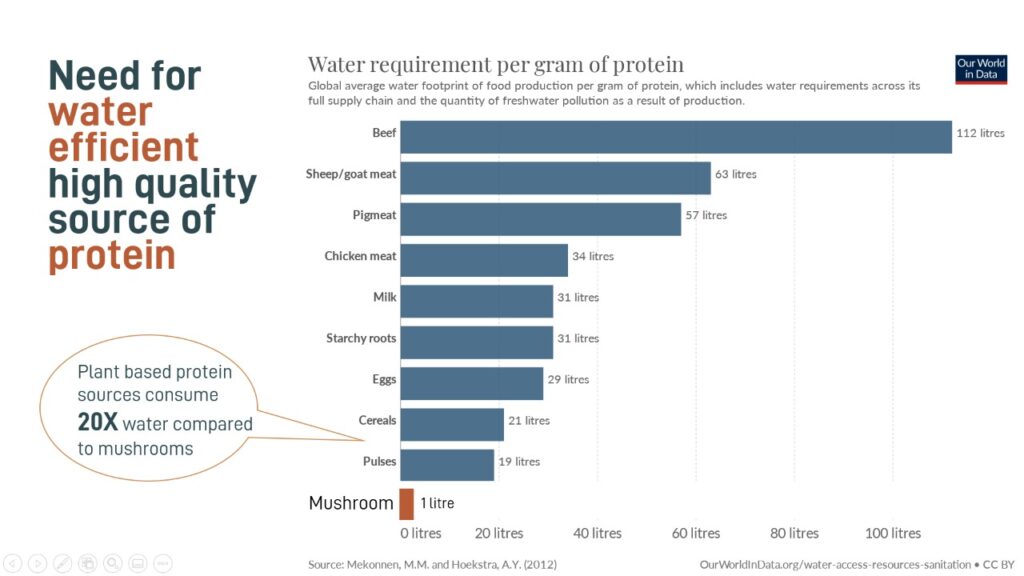Why India Needs More Mushroom Farmers (Part 2/3)
Health & wellbeing
“Mushrooms are miniature pharmaceutical factories, and of the thousands of mushroom species in nature, our ancestors and modern scientists have identified several dozen that have a unique combination of talents that improve our health.”
– Paul Stamets
Protein deficiency in the Indian diet
The Indian Market Research Bureau’s 2017 report states that measured against the recommended daily intake of 60g, 80% of Indians are protein deficient. The usual sources of proteins in a regular Indian diet consist of one cup of lentils, 1 glass of milk, or 1 cup (200 g) of yogurt which contains 7-8 grams of protein. In order to meet the requirement of 60g protein per day, it would be necessary to eat eight bowls of lentils or drink 7-8 glasses of milk which you and I both know is practically impossible!
Mushrooms are considered the highest producer of protein per unit area and time. This basically means that for a given area and a fixed time frame, compared to all other sources, mushrooms have the highest protein content. So, just how much protein does a mushroom contain? 100 g of dried Lentinus Sajor Caju commonly known as the Indian oyster mushroom contains around 28 grams of protein, which is as much as you would find in 100 g of chicken breast! Apart from absolute protein content, the quality of protein from mushrooms is superior to almost all other vegetarian sources. This is because mushrooms contain all of the 9 essential amino acids whereas most plant-based protein sources lack one or more of these or may not have them in the required quantities.
If you’re an environmentally conscious fitness enthusiast, you might want to swap your chicken steak for some mushrooms next time because it takes roughly 156 times the amount of water to produce 1 kg of chicken as compared to the same quantity of fresh mushrooms. Yet one more way in which mushroom cultivation can help society is by giving us the protein we need on a daily basis while using only a fraction of water and resources compared to popular alternatives.
By adopting mushrooms as part of our daily diet, we can bring about the much-needed shift towards vegetarian and sustainable sources of protein at an individual level. This can further encourage more farmers to take up mushroom cultivation as a means to support themselves in a more sustainable manner.
Increase in lifestyle disorders as the leading cause of death in India
A recent article by the business world states that nearly 61% of people in India die due to lifestyle diseases. Lifestyle diseases are ones that are connected to how people live their lives. Irregular sleep patterns, unhealthy food habits, lack of regular physical activity, and stress are the leading causes of lifestyle disorders. Major lifestyle disorders most prevalent in India are obesity, hypertension, heart disease & stroke, type-2 diabetes, cancer, and Alzheimer’s.
With advances in technology and the ever-increasing pace of life, lifestyle disorders are here to stay. Which leads us to the question of how mushrooms could possibly play a role in this?
Well, it turns out that many mushrooms contain novel compounds which can help us treat or manage many of the disorders mentioned above. Let’s take a look at a few common examples of medicinal mushrooms and their benefits:
From the above list, it is quite obvious that adding a dose of some of these potent medicinal varieties of mushrooms to your daily diet can help prevent or treat many of the most prevalent lifestyle disorders of today. No wonder mushrooms such as Reishi, which is regarded as the mushroom of immortality in China, have been used in traditional Chinese medicine for the last 10,000 years! India, with its rich heritage of natural remedies, should seriously consider adding these powerful medicinal mushrooms to its already vast arsenal of herbs.
Promoting awareness about the healing potential of mushrooms and their uses can help increase access to alternative healing remedies, which can improve the quality of life of millions of Indians who seek relief from their health conditions on a day-to-day basis.
I’ll be taking into account the other issue in the next blog piece stay tuned folks for Part 3: Why India Needs More Mushroom Farmers.
Read Part 3 here: https://nuvedo.com/2022/01/05/why-india-needs-more-mushroom-farmers-part-3-3/
2 thoughts on “Why India Needs More Mushroom Farmers (Part 2/3)”
Leave a Reply
You must be logged in to post a comment.




 Jashid is the co-founder of Nuvedo. An IIM graduate, with a bachelors in manufacturing engineering from BITS Pilani, his interest with fungi and mushrooms started with looking for alternate sources of vegetarian protein. He loves talking about mushrooms, spending time with them and studying their behavior in all shapes and forms. The role of fungi in the natural ecosystem, with mushrooms being at the forefront, led him to explore their structures, benefits and cultivation. Bringing his experience in retail and sustainability together, through a lens of permaculture, he cofounded Nuvedo with the aim of bringing legitimate, gourmet, and medicinal mushrooms to Indian people. He is committed towards spreading the nutritive and therapeutic properties of mushrooms while building an ecosystem of trust with the community. His love for people and passion for mushrooms has evoked the birth of this organization.
Jashid is the co-founder of Nuvedo. An IIM graduate, with a bachelors in manufacturing engineering from BITS Pilani, his interest with fungi and mushrooms started with looking for alternate sources of vegetarian protein. He loves talking about mushrooms, spending time with them and studying their behavior in all shapes and forms. The role of fungi in the natural ecosystem, with mushrooms being at the forefront, led him to explore their structures, benefits and cultivation. Bringing his experience in retail and sustainability together, through a lens of permaculture, he cofounded Nuvedo with the aim of bringing legitimate, gourmet, and medicinal mushrooms to Indian people. He is committed towards spreading the nutritive and therapeutic properties of mushrooms while building an ecosystem of trust with the community. His love for people and passion for mushrooms has evoked the birth of this organization.
Hi,
Could you kindly link the source of the protein content mentioned here? Couldn’t find it in the IIHR website. As someone who is trying to find more vegetarian complete protein sources in my diet, this is very useful.
USDA database just has data on just 1 Oyster mushroom variant : https://www.nutritionix.com/food/oyster-mushroom
NuMushTe Vijesh!
Thank you for your comment! We used the data published by IIHR in their latest edition of their paid Nutrition Bulletin on Mushrooms. Unfortunately this file is not available for the public to use. For understanding the nutritional profile of different oyster mushrooms you can even refer the scientific paper titled “Comparative Study of the Nutritional Composition of Oyster Mushrooms Cultivated in Bangladesh”. What needs to be noted is that the variation in samples from the same species can happen due to a number of factors including- strain used, substrate used, cultivation parameters etc. Hope this helps!